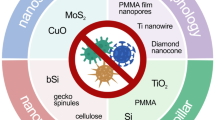Abstract
Recently bacterial cells have become attractive biological templates for the fabrication of metal nanostructures or nanomaterials due to their inherent small size, various standard geometrical shapes and abundant source. In this paper, nickel-coated bacterial cells (gram-negative bacteria of Escherichia coli) were fabricated via electroless chemical plating. Atomic force microscopy (AFM) and transmission electron microscopy (TEM) characterization results reveal evident morphological difference between bacterial cells before and after deposition with nickel. The bare cells with smooth surface presented transverse outspreading effect at mica surface. Great changes took place in surface roughness for those bacterial cells after metallization. A large number of nickel nanoparticles were observed to be equably distributed at bacterial surface after activation and subsequent metallization. Furthermore, ultra thin section analytic results validated the presence and uniformity of thin nickel coating at bacterial surface after metallization.
Similar content being viewed by others
References
Ely O, Pan C, Amiens C, et al. Nanoscale bimetallic CoxPt1-x particles dispersed in poly(vinylpyrrolidone): synthesis from organometallic precursors and characterization. J Phys Chem B, 2000, 104(4): 695–702
Schmid G, Chi L F. Metal clusters and colloids. Adv Mater, 1998, 10: 515–526
Braun E, Eichen Y, Sivan U, et al. DNA-templated assembly and electrode attachment of a conducting silver wire. Nature, 1998, 391: 775–778
Keren K, Krueger M, Gilad R, et al. Sequence-specific molecular lithography on single DNA molecules. Science, 2002, 297: 72–75
Ford W, Harnack O, Yasuda A, et al. Platinated DNA as precursors to templated chains of metal nanoparticles. Adv Mater, 2001, 13: 1793–1797
Kirsch R, Mertif M, Pompe W, et al. Three-dimensional metallization of microtubules. Thin Solid Films, 1997, 305: 248–253
Markowitz M, Baral S, Brandow S, et al. Palladium ion assisted formation and metallization of lipid tubules. Thin Solid Films, 1993, 224: 242–247
Mertig M, Kirsch R, Pompe W, et al. Fabrication of highly oriented nanocluster arrays by biomolecular templating. Eur Phys J D, 1999, 9: 45–48
Wong K K W, Mann S. Biomimetic synthesis of cadmium sulfide-ferritin nanocomposites. Adv Mater, 1996, 8: 928–931
Xu L N, Zhou K C, Xu H F, et al. Copper thin coating deposition on natural pollen particles. App Surf Sci, 2001, 183: 58–61
Li X F, Li Y Q, Cai J, et al. Metallization of bacteria cells. Sci China Ser E-Tech Sci, 2003, 46(2): 161–167
Berry V, Saraf R F. Self-assembly of nanoparticles on live bacterium: an avenue to fabricate electronic devices. Angew Chem Int Ed, 2005, 44: 6668–6673
Berry V, Rangaswamy S, Saraf R F. Highly selective, electrically conductive monolayer of nanoparticles on live bacteria. Nano Lett, 2004, 4(5): 939–942
Amiel C, Mariey L, Denis C, et al. FTIR spectroscopy and taxonomic purpose: contribution of the classification of lactic acid bacteria. J Travert, 2001, 81: 249–255
Curk M C, Peladan F, Hubert J C. Fourier transform infrared (FTIR) spectroscopy for identifying lactobacillus species. FEMS Microbiol Lett, 1994, 123: 241–248
Beveridge T J. Ultrastructure, chemistry, and function of the bacterial wall. Int Rev Cytol, 1981, 72: 229–317
Beech I B. The potential use of atomic force microscopy for studying corrosion of metals in the presence of bacterial biofilms — An overview. Int Biodet Biodeg, 1996, 37: 141–149
Beech I B, Cheung C W S, Johnson D B, et al. Comparative studies of bacterial biofilms on steel surfaces using atomic force microscopy and environmental scanning electron microscopy. Biofouling, 1996, 10: 65–77
Grantham M C, Dove P M. Bacterial-mineral interactions: investigations using Fluid Tapping Mode atomic force microscopy. Geochim Cosmochim Acta, 1996, 60: 2473–2480
Wang J, He S Y, Xu L N, et al. Probing nanomechanical properties of nickel coated bacteria by nanoindentation. Mater Lett, 2006, 61(3): 917–920
Author information
Authors and Affiliations
Corresponding author
Additional information
Supported by the National Natural Science Foundation of China (Grant Nos. 60171005, 60371027, 60121101, 20573019 and 90406023) and Open Project Foundation of Laboratory of Solid State Microstructures of Nanjing University
About this article
Cite this article
Wang, J., He, S., Xu, L. et al. Transmission electron microscopy and atomic force microscopy characterization of nickel deposition on bacterial cells. CHINESE SCI BULL 52, 2919–2924 (2007). https://doi.org/10.1007/s11434-007-0390-y
Received:
Accepted:
Issue Date:
DOI: https://doi.org/10.1007/s11434-007-0390-y




